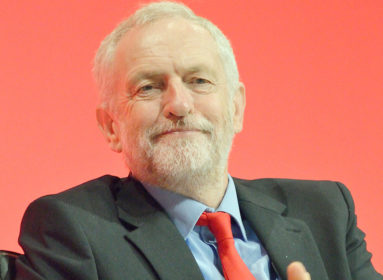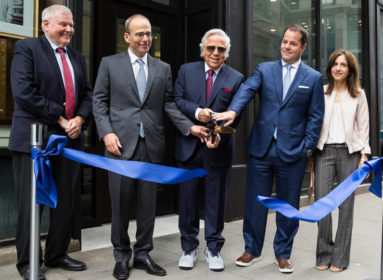
By Cindy Mindell
HAMDEN – This year marks the 175th anniversary of Congregation Mishkan Israel (CMI), the oldest Jewish congregation in Connecticut, the 14th oldest continuously operating synagogue in America, and the oldest continuously operating synagogue in New England. The synagogue traces its roots back to 1840, when New Haven was home to some 20 families who had fled the economic and social oppression in their native Bavaria, Germany.
The congregation will mark this significant milestone with a series of year-long events that kicked off in January with an interfaith service honoring the late Dr. Martin Luther King, Jr., and will continue on March 1 with a tour of the synagogue’s collection of artwork and its architecture. The interfaith service as well as the artwork and architecture are all a reflection of Mishkan Israel’s past – and the past, says the congregation’s spiritual leader, Rabbi Herbert Brockman, is what this year of celebration is all about.
“I’d hope the congregation would be one that treasures its past and has confidence in its future, a congregation with ties to the entire community, respected and honored and one which appreciates its own unique and sacred heritage,” Brockman told the Ledger. “I especially hope that it will maintain deep ties with a thriving State of Israel, and be a partner with Jews around the world. This year is given to celebrate all that came before us. We built on the hopes and dreams of those courageous Jews who came to New Haven in the 1830s and ‘40s and built this amazing synagogue. We do not take that for granted.”
The congregation purchased burial land in Westville and would meet for worship services in individual homes and offices until 1843. That year, the Connecticut Legislature allowed non-Christian organizations to incorporate in the state, thereby enabling Jews to officially establish synagogues. The congregation set up its first synagogue in a room over the Heller & Mandelbaum store in a building on the corner of Grand Avenue and State Street.
In 1849, the congregants rented larger quarters in the Brewster Building at the corner of State and Chapel Streets. They met in various venues until 1856, when a $5,000 bequest from New Orleans philanthropist Judah Touro allowed for the purchase of the Third Congregational Church, an Ionic Greek temple-style building on Court Street. That year, a New Haven chapter of B’nai B’rith was established, some of whose members campaigned successfully to align the congregation with the Reform movement. As a result, Orthodox members of Mishkan Israel left to form Congregation B’nai-Shalome.
A commitment to pursuing justice and social cohesion was evident from CMI’s earliest history. The congregation began holding services with local clergy of other faiths as early as 1847. In 1858, CMI joined the international protest against the kidnapping and baptizing of a Jewish child, Edgardo Mortara, in Bologna, Italy. In the 1870s, Rabbi Judah Wechsler forged the congregation’s commitment to interfaith activities with his “no unfriendly words” policy, preaching unity, harmony, and respect for religious differences.
In the late 1800s, as Jews poured out of Eastern Europe, the congregation helped resettle Russian-Jewish refugees, who founded several new synagogues of their own in New Haven. By the mid-1890s, with 190 families, the congregation moved to a larger facility on Orange Street. CMI established the first free Hebrew school for all Jewish children in the early 1900s.
Toward the end of the 19th century, CMI appointed its first American-born rabbi, David Levy, who modernized services and sought to bring the congregation fully into the 20th century. Having just celebrated its 50th anniversary, the congregation decided to seek a new home “commensurate with the position of dignity it occupied.” A lot was purchased on the corner of Audubon and Orange Streets, financed by the sale of the Court Street synagogue for $20,000 and a $60,000 mortgage. The new facility was designed specifically as a Jewish house of worship by architects Arnold Brunner and Thomas Tryon, acclaimed for their designs of Congregation Shearith Israel and Temple Israel, both in New York City.
The new synagogue was built in the Spanish Renaissance architectural style, with two 84-foot-high towers flanking the front entrance. A broad flight of 14 steps led up to the wide vestibule, whose roof was supported by four large carved pillars and whose floor was inlaid with rich mosaic. The pulpit was surrounded by a large marble column at each corner. The architects filled the interior with classical elements – arches, pilasters, mosaic-tiled floors, stained-glass windows, and Corinthian columns.
By the early 1950s, Congregation Mishkan Israel had outgrown the building with more than 700 member families. In 1955, the congregation purchased a plot of land on Ridge Road in Hamden and hired architects Fritz Nathan and Bertram Bassuk. The Ridge Road synagogue features stained-glass windows and art by several renowned Jewish artists.
In his 1888 book, The Hebrews in America: A Series of Historical and Biographical Sketches, Isaac Markens describes CMI as “one of the liberal congregations of the country.”
That reputation was strengthened on the national stage by Rabbi Robert E. Goldburg, who led the congregation from 1948 to 1982 (and was perhaps most famous outside the Jewish world for supervising Marilyn Monroe’s conversion before her marriage to Arthur Miller). Personally committed to social justice, Goldburg welcomed Dr. Martin Luther King, Jr. to speak at the synagogue in 1961 and was arrested alongside the Civil Rights leader during a protest in Georgia the following year. A decade later, the congregation would welcome peace activist Bruce M. Cohen, who served as assistant rabbi before establishing Interns for Peace in Israel in 1976.
Goldburg’s outspoken opposition to the Vietnam War split the congregation, with many complaints about his public activism and politically-themed sermons and synagogue programs. In response, Goldburg said, “I think that anyone who assumes religious obligations to speak the truth must do it.”
CMI’s annual interfaith service in tribute to Martin Luther King, Jr., inaugurated in 2010 by current spiritual leader Rabbi Herbert Brockman, remains an homage to Goldburg’s philosophy. This year, the congregation’s 175th anniversary celebration kicked off with the annual service, headlined by keynote speaker Rabbi David Saperstein.
After Goldburg retired, the congregation was led by Rabbi Mark Panoff and then Herbert N. Brockman, a seventh-generation rabbi who arrived in 1986 and became a leading voice in the local interfaith community.
In 1989, Mishkan Israel opened its doors to the Urban Youth Center, a program for inner-city middle-schoolers. The congregation has sponsored the resettlement of refugees from the arrival of Soviet Jews in the early ‘90s on. Today, with some 600 members, CMI’s commitment to the community continues with the Pe’ah Project, a congregant-run garden which provides more than a ton of vegetables annually to community soup kitchens.
The congregation remains committed to promoting interfaith understanding and to supporting social justice issues, says Brockman.
“There is a tradition that Moshe came back and sat in the House of Study. The Rabbis were arguing a point of law which Moshe did not understand. But when the rabbis concluded, ‘This is according to the law of Moses,’ Moshe was satisfied. I hope (and pray) that our forebears are satisfied and are proud of us,” he says.
A special art and architecture tour on March 1, led by New Haven architect Ben Ledbetter, will highlight some of the many artworks by locally and internationally renowned Jewish artists. The idea for the tour came about as the anniversary committee was making plans for the year. Just walking past the sculptures on the synagogue’s front lawn or entering the sanctuary or chapel, it’s obvious that the building houses a trove of artwork.
“But we also suspected that there were pieces of art that people had donated over the years squirrelled away throughout the building,” says Joan Wallack, co-chair of the art and architecture tour committee. “We thought we could do something with them because the pieces we knew about were quite nice.”
A newly created permanent exhibition mounted in the synagogue’s main corridor features oil paintings and works on paper by Ben Shahn, Shraga Weil, David Levine, Jack Levine, Joseph Margulies, Elias Grossman, Saul Raskin, Norman Rubington, Irving Amen, Rudolph Pusak, Stanislaus Bender, and Herbert Lewis Fink. The works of local artists Hilda Levy, Florence Goodwin, and Birney Lettick are also featured.
Sculptural pieces displayed outdoors and inside include “Jacob Wrestling with the Angel” by Hartford native Elbert Weinberg, “Bronze Bust of Moses” by William Zorach, “Moses” by Dina Melicov, “The Burning Bush” by New Haven native Ann Lehman and “Bronze Bas-Relief of the Ten Commandments” and “Bronze Wall Sculpture of the Tree of Life” by Connecticut native Ruth Lapides.
The sanctuary is anchored by a 25-foot-high mosaic Decalogue with Hebrew calligraphy and floor-to-ceiling stained-glass windows inscribed with the names of biblical and modern prophets by renowned glass artist Robert Pinart. The space also features two prominent works by Shahn: a large silk wall tapestry of a menorah designed for his Haggadah for Passover and a drawing of Maimonides.
The chapel features a carved walnut Ark by sculptor Gilbert Franklin and a Decalogue and eternal light by goldsmith and silversmith Ludwig Wolpert, who pioneered the use of Hebrew letters as major artistic elements. The space includes several stained-glass windows by glass artist Jean-Jacques Duval.
Photo credit: Tomer Canaan
175th Anniversary Art & Architecture Tour: Sunday, Mar. 1, 10 AM-12 noon, Congregation Mishkan Israel, 785 Ridge Road, Hamden | Info: (203) 288-3877 / cmihamden.org.
For a schedule of anniversary events: cmihamden.org.
CAP: The Mishkan Israel sanctuary. Photo credit: Tomer Canaan








 Southern New England Jewish Ledger
Southern New England Jewish Ledger










